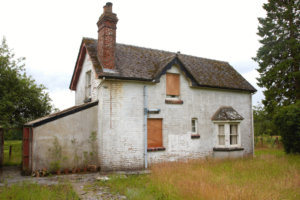
How to sell or claim on old derelict house in the UK
How to sell or claim on old derelict house in the UK In this article we will cover how you can sell or claim an old derelict house in the UK. Sell your house in 28 days WRITTEN BY: Tom






Whether you are buying or selling a property, chances are that you will need a conveyancing solicitor in order to progress you on your property journey.
Purchasing or selling a house can be a very complex task with several steps that you will need legal advice and help for and unless you have direct experience in the area, it is not something you will likely want to take on yourself.
We will be looking at how you can find the right solicitor or conveyancer for your purchase or sale, what the conveyancing process involves, what conveyancing fees you can expect and what is included in a conveyancing quote.
Looking for a quick answer? Check out our interactive menu below!
The role that solicitors and licensed conveyancers play in the conveyancing process is pretty much identical, it is their job to help guide and support you through the legal process behind a house purchase.
They use their legal services to help progress the sale and to take care of any legal issues that may arise.
Conveyancing fees are the amount of money that you pay your conveyancer so that the legal side of your house sale is progressed correctly.
The conveyancing costs you pay will be split into two categories, they will be either legal fees or disbursements:
According to the HomeOwners Association, these are the costs typically involved in the conveyancing process.
| Fee | Amount | Buying | Selling |
|---|---|---|---|
| Anti-money laundering checks | £6-£20 | Yes | Yes |
| Bankruptcy search | £4 | Yes | No |
| Title deeds copy | £6 | No | Yes |
| Local authority searches | £250-450 | Yes | No |
| Property fraud check | £10 | Yes | No |
| Transferring of ownership | £200-300 | No | Yes |
| Bank transfer fees | £20-30 | Yes | No |
| Stamp Duty Land Tax | 0-12% | Yes | No |
| Help to Buy supplement | £200-300 | Yes | No |
| Gifted deposit | £50-100 | Yes | No |
| Lifetime/Help to Buy ISA | £60 | Yes | No |
| Unregistered property fee | £120-240 | Yes | No |
| Leasehold property supplement fee | £200-300 | Yes | No |
| Managing agent packs | £300-800 | No | Yes |
| Average legal fees | £300-1500 |
When you are looking for a conveyancer or a conveyancing solicitor, there are many places that you can look. You can search online, ask family or friends, or consult your estate agent or mortgage lender.
However, it is important that you choose one that is fully regulated.
In order to make sure that your sale is progressed correctly, you should always use a solicitor who is regulated by the:
The first step of the conveyancing process is to instruct your solicitor.
Once you have accepted an offer on your property and instructed your conveyancer, they will undertake the legal work behind the house sale.
They will need to know your mortgage details from your lender as well as your name and address of the property as well as the agreed sale price.
Now that you have instructed your conveyancer, they will send you all of the paperwork necessary for the transaction to go through.
Once you have completed the legal documents and paperwork, they will be able to start the process.
There will be several detailed questionnaires about the property and what you will intend to include in the sale. Forms you can expect to fill out would be a TA6 form and the TA10 form. If the property is leased, then you will need to fill out the TA7 form.
You will also need to include any details about neighbour complaints, any known personal developments, and what you plan on leaving in the house. You will need to fill out these forms as truthfully as you can and to the best of your knowledge.
Your conveyancer will then use the information that you have provided to prepare the draft contract and will then send it over to the buyer’s conveyancer. The paperwork that they send will include the contract as well as the Land Registry documents and property information forms. Whilst they draft your contract, your conveyancer will find out whether the property is a freehold or a leasehold.
The next step will involve the buyer’s conveyancer reviewing the draft contract paperwork. They will then submit the pre-contract enquiries to your conveyancer who will then need your help to answer some of the enquiries. On top of this, they will also attempt to satisfy the enquiries, and once all parties are happy, they will move forward with the process.
The buyer will now need a property survey. This survey has the potential to alert the buyer to any repair work that may need to be carried out.
This can be used to renegotiate the original offer. In order to make things easier for the surveyor, you should prepare your property for the survey by having a general tidy-up.
The closer you get to exchanging the contracts, the more questions your buyer is likely to have.
You will have to answer any of the pre-contract enquiries.
Make sure that you answer any questions they may have as truthfully and as honestly as possible.
Now it is time to exchange contracts. This is done over the phone and involves each of the licensed conveyancers agreeing to send the other the signed contract.
Once this happens, the exchanging of contracts is legally binding. If the buyer pulls out now you will be able to keep the deposit.
This is the final step in the conveyancing process for selling.
On the completion day, you must vacate the property so that your buyer can move in. You will have legal ownership transferred from you to the buyer using the TR1 form and your mortgage will be paid off.
The deeds will then be sent to the buyer’s conveyancer.
The funds will then be used to pay the estate agent, plus any outstanding balance to your mortgage lender and the solicitor’s fees for selling a house.
The buyer’s conveyancer will then transfer the funds from the sale to your conveyancer, once the payment has been received, the completion will have taken place.
Once you have completed the sale, there are a few things that you will need to keep in mind to do on the day and after:
Once you have had an offer accepted on your property you must inform your conveyancer so that they can open your case.
They will need to be informed of the agreed sale price as well as your current address and full name. You will also need to inform your estate agent of your choice of solicitor.
Once you have instructed one solicitor, they will begin to draw up a draft contract which will set out the charges and deposits required. You will need to read over the papers and return them as soon as you can to your solicitor.
Next, your solicitor will write to the seller’s solicitor to confirm they have been instructed. Your solicitor will then be provided with a contract pack that will include the legal documentation required for the sale such as the property information form and the fittings and contents form.
You should now look for a property surveyor who will conduct a survey on the property.
This will alert you to any damage to the property structure and will save you a lot of money in the long run. If the survey unveils poor results, you can use this as leverage to negotiate a cheaper price, or you can walk away.
Now your conveyancer will order conveyancing searches with the local council.
These searches are designed to highlight any legal or environmental issues with either the house or the land near the property. They include an Environmental Search, a Water and Drainage Search, and a Local Authority Search.
Your conveyancer will review the draft contract paperwork once they have received the results from the property surveys.
The timescale for this is around 0-3 weeks after an offer has been accepted.
Your conveyancer will discuss their findings with you and give you the opportunity to ask any questions about the results.
At this stage in the process, it is up to your conveyancer to approach the seller’s conveyancers to raise any pre-contract enquiries.
It is vital that you make sure to have risen any enquiries and that you have read through the contract pack before this time.
It is your conveyancing solicitor’s job to prepare the draft transfer deed and completion information form which will be sent to the seller’s conveyancer for approval. Your conveyancer will carry out extra pre-completion searches and prepare a completion statement.
Once you are happy to proceed, your conveyancer will make arrangements for the deposit to paid to the seller.
The next step in the process is to exchange contracts. It is at this point that the sale becomes legally binding. If you pull out of the sale after this point, you will face financial consequences.
It will be up to your conveyancer to make sure that they have the correct documentation ready to exchange. Once the conveyancers on both sides of the sale are ready then the exchange of contracts will happen via a phone call.
This is the final step in the conveyancing process.
When completion day rolls around, ownership is legally transferred to you and the sale is completed.
From here your conveyancer will ask for your finances from your lender and the money will be transferred to the seller.
Once completion day is over, there will be a 30-day window for you to pay any of the stamp duty or Land Transaction Tax due for the property.
Your solicitor will then send the stamp duty to HMRC. They will then receive the title deeds, transfer deeds as well as proof that the seller has paid any outstanding payments on the mortgage.
Now that you are the new owner of the property, your conveyancer will register you as such with the Land Registry by sending your TR1 form and mortgage deal over.
You will then also receive copies of the registered title deed shortly after the completion day.
Online conveyancing services are an often cheaper way of progressing your sale. As it is online, the fees are often lower than that of high street conveyancing firms.
While this cheap conveyancing may seem tempting, you need to be aware that it comes at a price as online conveyancers can often advertise a great price but add additional services that push the conveyancing fees up a considerable amount.
Whilst it is not recommended, it is possible to carry out the conveyancing process yourself. If it is a simple transition and you are confident in your ability to understand the legal jargon and the conveyancing process, then you would be able to attempt it.
However, as there are so many legal documents that need signing and many legal hoops to jump through, it is often a good idea to save yourself the hassle and instead hire a solicitor to progress the sale for you.

How to sell or claim on old derelict house in the UK In this article we will cover how you can sell or claim an old derelict house in the UK. Sell your house in 28 days WRITTEN BY: Tom

Selling A House With Subsidence: How Easy Is It? In this article, we will break down what Subsidence is, what the signs are, what underpinning is and how easy it is to sell a house with Subsidence. Tom Condon ★

What Is A Red Book Valuation? Join us as we break down what a red book valuation is and why you would use one. Tom Condon ★ Digital Content Writer Table of Contents When it comes to assessing the value

Do You Need A Solicitor To Sell Your House? Looking at whether you need a solicitor to sell your house, and the difference between solicitors and conveyancers. Tom Condon ★ Digital Content Writer Table of Contents Do You Need A

What’s The Difference Between Exchange And Completion? Property Buying & Selling Guide To Conveyancing Tom Condon ★ Digital Content Writer Table of Contents What’s The Difference Between Exchange And Completion? It doesn’t matter if you are buying or selling

Everything you need to know about the Memorandum of Sale This article will cover everything you need to know about the Memorandum of Sale when selling a property. Sell your house in 28 days WRITTEN BY: tom condon ★ Digital

© 2022 The Property Selling Company
0800 111 4118
Email Us
4 Deighton Close, Wetherby, LS22 7GZ
© 2022 The Property Selling Company
The Property Selling Company is part of The Property Buying Company Limited (Registration No. 08023018) is incorporated in England and Wales. Registered office: 4 Deighton Cl, Wetherby LS22 7GZ